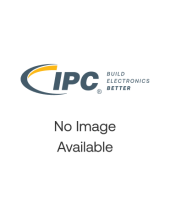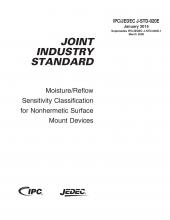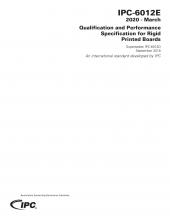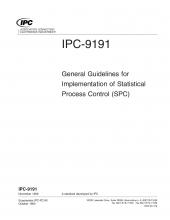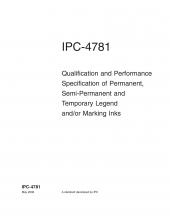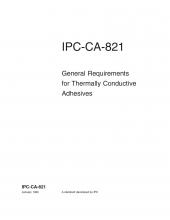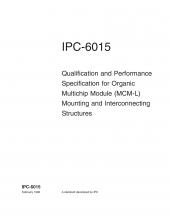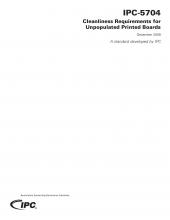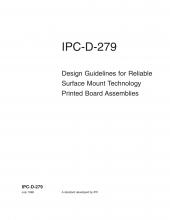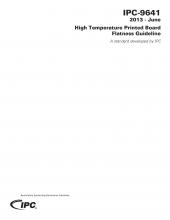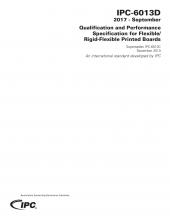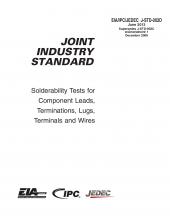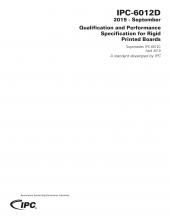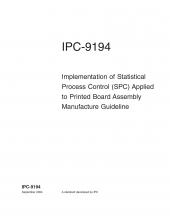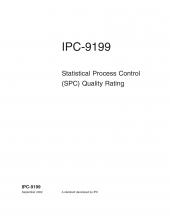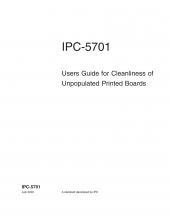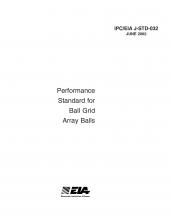Products
This redline provides a side-by-side comparison the changes from Revision C to Revision D of IPC-7711/21.
IPC JEDEC J-STD-020 is used to determine what moisture-sensitivity-level (MSL) classification level should be used so that surface mount devices (SMDs) can be properly packaged, stored and handled to avoid subsequent thermal and mechanical damage during the assembly solder reflow attachment and/or repair operation. J-STD-020 covers components to be processed at higher temperatures for lead-free...
This document is intended to clarify terms used in the area of fluid dispensing. As is often the case, different terms are used by different manufacturers to convey a similar meaning. Common interchangeable terms are shown in parenthesis and the reader should not infer one term is preferred over the other.
IPC-6012E specification covers qualification and performance of rigid printed boards, including single-sided, double-sided, with or without plated-through holes, multilayer with or without blind/buried vias and metal core boards. It addresses final finish and surface plating coating requirements, conductors, holes/vias, frequency of acceptance testing and quality conformance as well as electrical...
Contains over 150 industry approved test techniques and procedures for chemical, mechanical, electrical, and environmental tests on all forms of printed boards and connectors. New and updated test methods are available for download at https://www.ipc.org/test-methods.
This standard establishes construction detail requirements for bumps and other terminal structures used for Flip Chip Scale carriers. The specific standards for different terminations are appropriately matched to a particular interconnection process and include such diverse terminations as solder bumps, columns, non-melting stand-offs and conductive polymer deposits. The document articulates a set...
IPC-9191 reflects the principals of statistical process control (SPC) represented by ISO/DIS 11462-1, Guidelines for Implementation of Statistical Process Control (SPC) -- Part 1: Elements of SPC. This document outlines the SPC philosophy, implementation strategies, tools, and techniques used for relating process control and capability to final product requirements. Supersedes IPC-PC-90.
The industry's first specification for the evaluation of a legend and/or marking ink material for the determination of acceptability of use in a standard printed board system. IPC-4781 provides coverage for adhesion, material qualification and testing, resistances to solvents, requirements for resistance to lead-free solders, and electrical requirements. 17 pages. Released May 2008.
Covers requirements and test methods for thermally conductive dielectric adhesives used to bond components in place. Permanent, removable and self-shimming adhesives are addressed. 18 pages. Released January 1995.
Establishes the specific requirements for organic mounting structures used to interconnect chip components, which in combination form the completed functional organic single-chip module (SCM-L) or organic multichip module (MCM-L) assembly. Includes the quality and reliability assurance requirements that must be met for their acquisition. For use with IPC-6011. 25 pages. Released February 1998.
Printed board quality encompasses many parameters, cleanliness being one important parameter. This document defines the recommended general requirements for the cleanliness of unpopulated (bare) single, double-sided and multilayer printed boards. Coverage is given to Ion Chromatography (IC) testing and Ionic cleanliness testing for process control. 6 pages. Released December 2009.
Establishes design concepts, guidelines and procedures for reliable printed wiring assemblies. Focuses on SMT or mixed technology PWAs, specifically addressing the interconnect structure and the solder joint itself. Discusses substrates, components, attachment materials, coatings and assembly processes and testing considerations. In addition, this document contains detailed appendices covering...
This voluntary standard establishes minimum requirements for the design, installation, operation and maintenance of electrically heated process equipment in order to minimize electrical hazards and prevent fires that may occur in combustible tanks, tank liners and drying equipment.
Establishes requirements, definitions and certification provisions for optical inspection aids. Defines inspection grades to be used as accept/reject criteria for optical inspection aids. 40 pages. Released October 1993.
Printed board flatness is largely affected by a change in intrinsic properties through exposure to variances in temperature. The worst case deviation of the printed board from flatness may be at room temperature, peak temperature during reflow, or at any temperature in between. Printed board flatness must therefore be characterized during the entire reflow thermal cycle, and not solely at room...
The IPC-6013D covers qualification and performance requirements for flexible printed boards designed to IPC-2221 and IPC-2223. The flexible printed board may be single-sided, double-sided, multilayer or rigid-flex multilayer. All of these constructions may include stiffeners, PTHs, microvias, and blind/buried vias. IPC-6013D incorporates new and updated requirements for final finishes, rigid-to...
This standard prescribes test methods, defect definitions, acceptance criteria, and illustrations for assessing the solderability of electronic component leads, terminations, solid wires, stranded wires, lugs and tabs. A test method for the resistance to dissolution/dewetting of metallization is also included in the standard. Intended for use by both vendors and users, J-STD-002D was developed by...
This specification covers qualification and performance of rigid printed boards, including single-sided, double-sided, with or without plated-through holes, multilayer with or without blind/buried vias and metal core boards. It addresses final finish and surface plating coating requirements, conductors, holes/vias, frequency of acceptance testing and quality conformance as well as electrical...
The European Union’s Restriction of Hazardous Substances (RoHS) legislation has had a profound impact on the electronics industry. One of the restricted substances, lead (Pb), is commonly used in alloys with tin for component finishes, printed board finishes and solders. Pb-free materials directly affect product performance, reliability and service life in many ways. There have been numerous...
This guideline standard is intended to aid in interpretation of the requirements in IPC-9191, "General Guidelines for Implementation of Statistical process Control," specifically for printed board assembly (PBA) manufacture. This document and IPC-9191 should be used together; the standards are cross-referenced to each other in the Appendices of this guideline. This standard promotes process...
This standard identifies the moisture sensitivity classification level of passive surface mount devices and through-hole components, subjected to reflow soldering, so that they can be properly packaged, stored, and handled to avoid subsequent thermal/mechanical damage during assembly solder reflow attachment and/or repair operation. This standard may be used to determine what classification level...
This document standardizes the performance parameters for air moving devices. The phrase "air moving device" (or "air mover") refers to equipment such as, fans, blowers and other forced air movement technologies. These air moving devices are used in the electronics industry for the cooling of heat-producing components, and range from small devices mounted directly to hot components such as...
This document is a tool for a customer or supplier organization's internal audit group to assess a statistical process control (SPC) system against the requirements of IPC-9191. This document should be used by customers and suppliers of any size and for any commodity. This tool can be used to perform an assessment of the use of SPC at both organizational and process levels. The questions in this...
Tackling PCB cleanliness is a tough job; residues on printed circuit boards are directly related to the reliability of the produced hardware and can result in serious failures if not known or monitored. But how do you measure "cleanliness"? How clean is "clean"? The IPC-5701 provides guidance into how these issues should be approached and specified in purchasing documents, addressing levels of...
This standard, developed jointly by IPC and the Electronic Industries Association (EIA) establishes the construction detail requirements for balls and other terminal structures on Ball Grid Array (BGA) packages. It also establishes a set of designations and expectations for product performance. A large variety of terminal structures are recognized for a wide range of applications ranging from...
Coming Soon
IPC-7095E: Design and Assembly Process Implementation for Ball Grid Arrays (BGAs)
IPC-7530B: Guidelines for Temperature Profiling for Mass Soldering Processes (Reflow & Wave)
IPC-2294: Design Standard for Printed Electronics on Rigid Substrates
IPC-6904: Qualification and Performance Specifications for Printed Electronics on Rigid Substrates
IPC-4105: Specification for Metal Base Copper Clad laminates for Rigid Printed Boards

